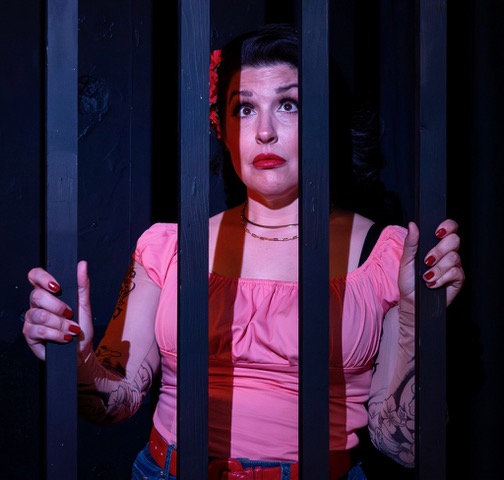Reviewed by Suzanne Angeo (Member, American Theatre Critics Association)
and Greg Angeo (Member Emeritus, San Francisco Bay Area Theatre Critics Circle)
Photos courtesy of Sean Carter Photography
Dickens’ Eternal Message Endures at MBT
Meadow Brook Theatre returns with yet another gorgeous, glowing production of “A Christmas Carol”. Now in its 41st year, many of the cast and crew are long-time veterans. This is must-see holiday theatre at its best, and is a longstanding tradition for many families in the Metro Detroit area. If you haven’t seen it yet, do so, and you will understand why.
Although the story is so well-known, and nearly ubiquitous this time of year ever since it was first published in 1843, “A Christmas Carol” by Charles Dickens remains an important and culturally relevant work. The timeless themes explored in this tale – charity for the poor, the treatment of children, love of home and family, hope and forgiveness – have become a central part of the Christmas celebration.
In his 37th performance, Thomas D. Mahard returns as the ideal Scrooge. He’s a man who lives a haunted, joyless existence, a pathologically greedy and unpleasant character. Can he find redemption with the help of four ghostly messengers? Or is Dickens telling us there is hope for everyone, no matter how far they’ve fallen, as long as someone still living believes in them? Aside from pondering the metaphysical, it’s fun to watch Mahard interact with the other characters, even if we know what’s coming.
Played by Antonio Vettraino, Scrooge’s good-natured nephew Fred offers a relentlessly cheerful contrast to his grouchy uncle. Scrooge’s dear departed business partner, Jacob Marley (in a brief but impressive turn by Anthony Guest), makes a dramatic entrance though a trap door, bound by heavy chains, accompanied by a riff of heavy metal music and a blast of smoke from the depths of you-know-where. He’s on a mission to save old Scrooge from a similar fate.
The gentle Spirit of Christmas Past (played to angelic perfection by Mary Magyari) transports Scrooge to his childhood and youth, where he sees the love he once had before he abandoned light for darkness. In an ingenious bit of casting, Tamara Della Anderson embraces the role of the boisterously jovial and kindly Spirit of Christmas Present (typically played by a bearded male actor). She presents Scrooge with delights and treats of the season – making us hungry – and takes him on a journey around London town this Christmas Eve night. He realizes, more than ever, what he’s missing and how he needs to change. In what is perhaps one of the most dramatic moments in the play, she reveals from beneath her flowing skirts two bedraggled children: a boy named Ignorance, and a girl named Want. Both are dangerous, the Spirit warns, but especially beware of Ignorance. It’s a message that reaches through the centuries.
Tolling bells and a crowd of mysterious people wielding black umbrellas, one of many unusual touches throughout the show, herald the arrival of Jacob Lipski as the towering, ominous Spirit of Christmas Future. If Scrooge’s tombstone is any indication, this spirit means business, and no humbug.
Other notable return performances include Stephen Blackwell as Bob Cratchit, Kristina Riegle as Bob’s wife, Chip DuFord as good old Fezziwig, and Stephanie Nichols as Mrs Fezziwig. On a recent Sunday matinee, fourth grader Conrad Nichols played the ever-adorable Tiny Tim. He alternates the role with another local lad, Chase Thomas.
Lovely costumes by Mary Pettinato lend the perfect early Victorian touch. Peter W. Hicks has created a massive, amazingly versatile rotating set that, combined with lighting by Reid G. Johnson, and sound design by Mike Duncan, transports you to Dickensian London.
Terry W. Carpenter’s direction is solid and well-practiced; he’s been involved with the show at Meadow Brook for most of its 41 performances as either director or stage manager. He’s also working with great material. The original adaptation and staging by Charles Nolte, a 30-plus-year veteran of Meadow Brook, is graced with wit and affection. There are some lively dance numbers (with original choreography by Jan Puffer) and general onstage merrymaking that lends a festive sparkle. Other creative touches include original use of music and sound effects, and other bits of stagecraft that set this production apart from previous years. But, an observation: Some of the child actors in key roles were difficult or impossible to hear in the back rows, so perhaps put mikes on the tykes?
Note: Be sure to arrive at least 30 minutes before curtain so you can catch the excellent a cappella choral group under the direction of CT Hollis, with arrangements by Caitlin Burke. They’re all dressed to the nines in period costumes, singing traditional Christmas carols and interacting with the audience, encouraging us to sing along. Then, when the curtain rises, they join their fellow Londoners onstage in a seamless transition to begin the play.
When: Now through December 24, 2023
Tickets $36 to $49
Where: Meadow Brook Theatre at Wilson Hall
Oakland University
378 Meadow Brook Rd
Rochester Hills, MI 48309
(248) 377-3300
www.mbtheatre.com
Special Note: As COVID-19 is a constantly changing situation, MBT will be monitoring and adhering to the guidance given by the CDC, the State of Michigan, the Actor’s Equity Association, and Oakland University. Check the Meadow Brook Theatre website for the latest information on efforts to keep everyone safe.
This production of A Christmas Carol is made possible through the generous support of the Michigan Arts and Cultural Council, the National Endowment for the Arts, the Fred and Barbara Erb Family Foundation, the Shubert Foundation and the Meadow Brook Theatre Guild.
Meadow Brook Theatre is a professional theatre located on the campus of Oakland University in Rochester, Michigan. MBT is a nonprofit cultural institution serving southeast Michigan for more than 56 years.











